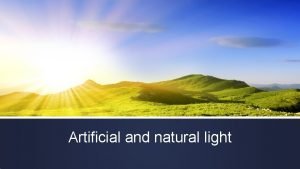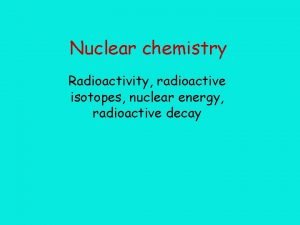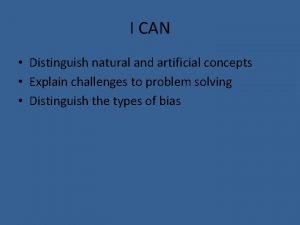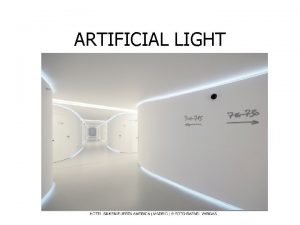Artificial and natural light Natural light Why is











- Slides: 11

Artificial and natural light

Natural light Why is it important? - The basis of life - Sunbeams warm the Earth’s surface and air - It influences your mood in a positive way and the Earth’s biorhythms (seasons, parts of the day) - It is necessary for our health (vitamin D) and for plants to make oxygen - You can save money (solar energy)

What is SUNLIGHT? ▪ portion of the electromagnetic radiation given off by the Sun ▪ sunlight is filtered through Earth's atmosphere ▪ when the direct solar radiation is not blocked by clouds/blocked by clouds ▪ ultraviolet radiation in sunlight has both positive and negative health effects ▪ sunlight is a key factor in photosynthesis ▪ Life on EARTH ▪ in prehistory, humans began to further extend this process by putting plant and ▪ animal materials to other uses ▪ most autotrophs, such as plants, use the energy of sunlight ▪ heterotrophs, such as animals, use light from the Sun indirectly by consuming the products of autotrophs

Moonlight • Light that reaches Earth from the Moon • Consisting mostly of sunlight and starlight • The intesity of moonlight varies greatly depending on the lunar cycle but even the full Moon typically provides only about 0. 05 -0. 1 lux illumination • Moonlight sometimes has a harmful influence • When the Moon is nearest to Earth and viewed at high altitude at tropical latitudes the illuminace can reach 0. 32 lux • The light of the Moon was thouhgt to worsen the symptomes of lunatics and to sleep in moonlight could make one blind or mad

Aurora • Aurora=Northern Lights • It’s a natural light in Antartic an Arctic regions • It looks like: long, narrow ares of light kink, fold, swirl or even ruffle like curtains • They are caused by the sun, who sends us a lot of energy and particles • Nitrogen: purple, blue light Oxygen: green, red light • Best places to see: Canada, Yukon, Nonovut, Alaska (North America) Scandinavcia, Norway, Russia (Europe)

Light and rainbows ▪ We can define rainbow as an optical event composed by a lot of tiny prisms. When the sunlight crosses over the drops in the sky, after or during a storm, drops shape a light spectrum in the sky. The rainbow development is characterized by 3 optical effects: ▪ Refraction ▪ Dispersion ▪ Reflection

Artificial light • Non-natural light • Light produced by electric lamps • Several types: • Incandescent Bulb • Halogen Lamp • Gaseous Discharge • LED (red, blue, green, white)

Chemical light • Bioluminescence is the ability of biolgical beings to emit light ▪ In fireflies and bacteria it works thanks to enztyme luciferase ▪ It oxides an aldehyde saturated long-chain following the ereaction • In 1937 a German forensic scientist discovered the use of luminol in the presence of blood. • Luminol is used in forensic research.

THOMAS EDISON • Was an American inventor and businessman • In 1878 he began working on a system of eletrical illumination • He wanted to create a long – lasting incandescent lamp, something that would be needed for indoor use • Early bulbs had flaws as an extremely short life, high expence to produce, and high electric current drawn • The first successful test was on October 22, 1879 (it lasted 13. 5 hours) • By November 4, 1879 was filed for U. S. patent 223 898 for an electric lamp using „a carbon filament or strip coiled and connected to pülatina contact wires” • This was the first commercially practical incandescent light

Artificial light and agriculture • light is an essential factor for plant germination • LED lighting • great effect on the plant’s growth cycle • extreme climatic changes • to replace the natural sunlight

Thank you for your attention!
 Artificial natural light
Artificial natural light Andreas carlsson bye bye bye
Andreas carlsson bye bye bye Natural and artificial radioactivity
Natural and artificial radioactivity Fission and fusion similarities
Fission and fusion similarities Natural and artificial radioactivity
Natural and artificial radioactivity Centric and eccentric occlusion
Centric and eccentric occlusion Natural and artificial food additives
Natural and artificial food additives Artificial concepts
Artificial concepts Difference between natural and artificial greenhouse
Difference between natural and artificial greenhouse Light light light chapter 23
Light light light chapter 23 Light light light chapter 22
Light light light chapter 22 Chapter 22
Chapter 22





















